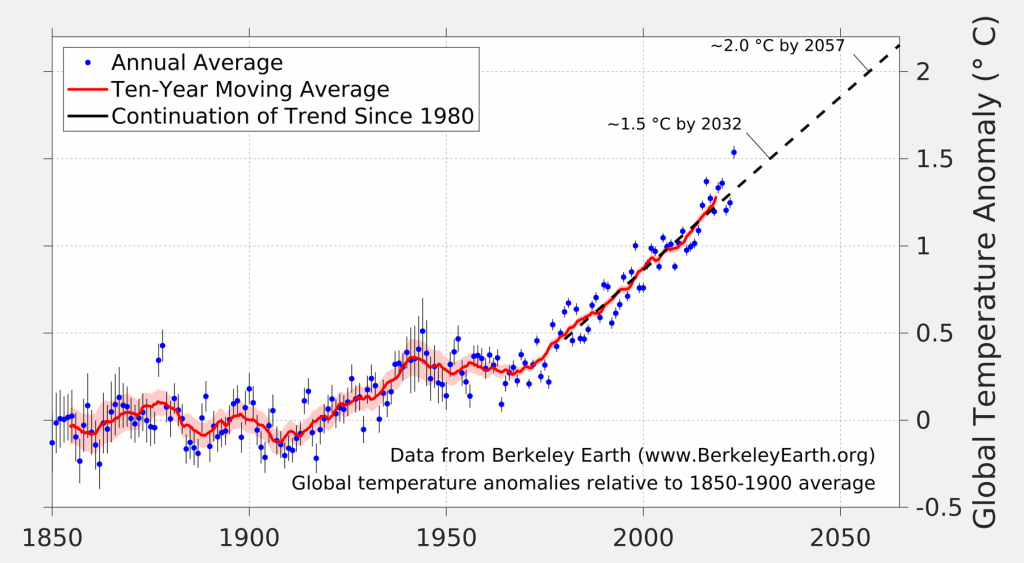
Gavin Schmidt (one of the world’s most respected climate scientists), in a commentary published in Nature, expressed his shock on the unprecedented warming that happened in 2023. The amount of warming exceeded even the most pessimistic range in all of the major climate models used to reconstruct global average temperatures. The cause of this abrupt warming is not captured by any potential confounding factor (namely the Hunga Tonga–Hunga Ha‘apai volcanic eruption and a reduction in sulphur emissions from ocean-crossing ships), and therefore must be some unaccounted for feedback resulting from global warming.
As a climate scientist, I am often asked to explain climate change. As a paleoclimate focused scientist and modeller, I am able to give context to the current global warming in terms of how climate changed in the past. I can explain that past climate changes were a result of changes in the duration of Northern Hemisphere summer from shifts in the Earth’s orbit, which in turn is modulated by changes in greenhouse gases. We can trust that the current warming must be a result of anthropogenic increases in greenhouse gases, because the orbital changes that drove past climate change happen on time scales of 10s of thousands of years. Even natural abrupt events, known as Dansgaard-Oeschger Events, probably took decades to centuries to manifest globally.
By becoming a climate scientist, I opened a Pandora’s Box. Over time, as I became more familiar with past climate changes and the models used to forecast climate change, the picture of what is to come gets clearer and clearer. From that knowledge, I know that the fact that the statistical models used to forecast the next year’s warming were off the mark for 2023 is not entirely surprising. The models can only take account what they know from past observations and processes. If something new manifests, the model cannot cope. I am sure the next few years will be a scramble to find out what that new thing was (I expect it will be some unaccounted for feedback in the Atlantic Ocean). Climate change is not necessarily linear and we should not be surprised if there are step-changes in the global warming trend.
There are many consequences to the current global warming trend that are already being observed, and frequency and severity of these events are increasing in many places:
- Increased frequency of extremely hot days
- drought
- extreme rainfall events
- increased severity of typhoons/hurricanes
- sea level rise and coastal erosion
- Reduction in freshwater resources due to decreases in mountain snowfall and shrinking glaciers
- spread of vectors for disease due to shorter winters
These will inevitably lead to many problems (among others):
- Migration of people due to their homes becoming ill suited for habitation
- Crop failures and famine
- Migration of animals used for food to different locations due to changes in habitat
- Challenges in maintaining water based transportation routes
- Razing of forests
- Devastating warfare
Often when I describe things like this to people who are not climate scientists, the question I get is “how do you deal with this knowledge”. When we think about the above problems, they are not really new to human civilization. This is possibly out of the collective memory in places (e.g. “Western” countries) that have escaped the so-called “Malthusian Trap” (i.e. where population is limited by food, resources, and disease). It has been less than a century since even those places faced down many of these problems. The problems associated with climate change are going to cause a lot of stress to human civilization that (perhaps temporarily) escaped these problems, and conflict is likely inevitable. But it is important to remember, that none of this is new, and humans can and have overcome these challenges.
As individuals, these large scale problems are so big that they can seem overwhelming and hopeless. But the things is, we do not have to be in this alone. Humans are a social animal, and it is no coincidence that those that work against action on climate change try to pin things on individual responsibility. They want division and they want us to believe that individuals are responsible.
So, it is very important to understand that individuals are not perfect, and to not feel burdened if you cannot live a life of complete virtue. Action on climate change starts by being social. Go out and find friends and join with them. Do things you enjoy! For me, this includes going out for drinks, hiking and running, and traveling. Find those who share what you love, and you will also find kindred spirits that can help alleviate the dread.
From there, you can start to think about solidarity in terms of climate action. The reason why many places escaped the Malthusian Trap in the first place was through solidarity movements like unionizing and expanding democratic governance. It is no coincidence that some of the largest efforts to mitigate environmental problems (for instance reducing CFCs and acid rain) came after the solidarity movements of the 50s, 60s and 70s. By finding collaborators through community building, you can start move forward with actions that can actually make a difference. You are not alone!

You must be logged in to post a comment.